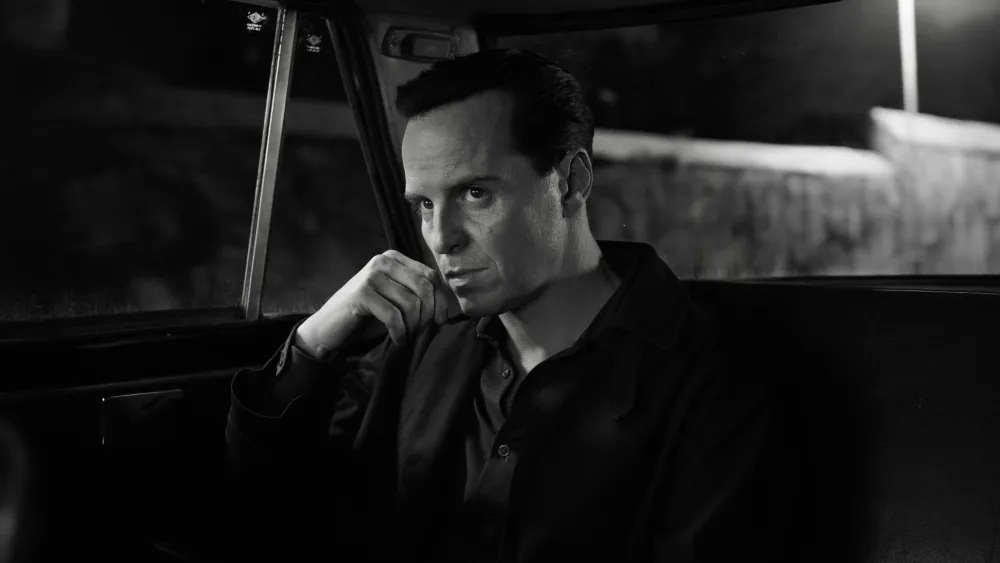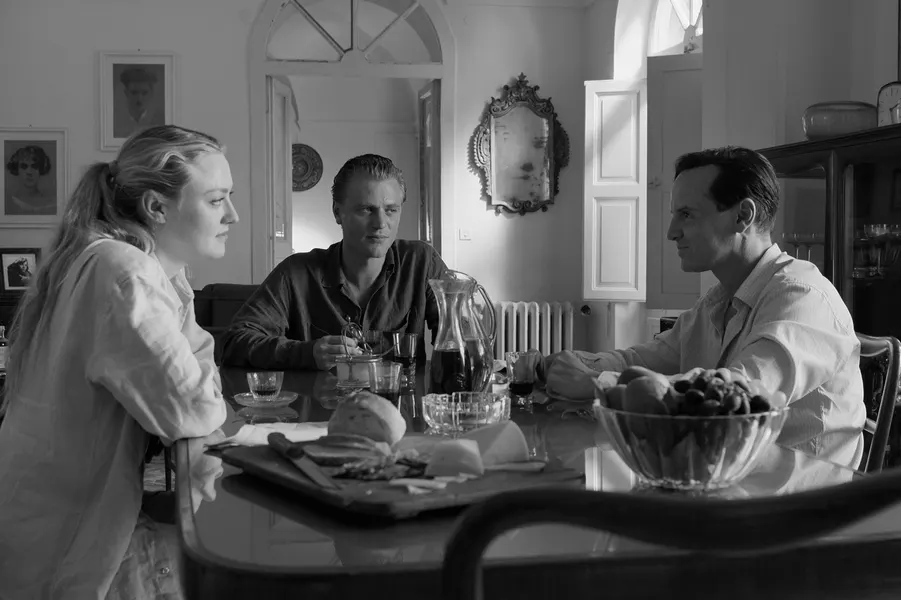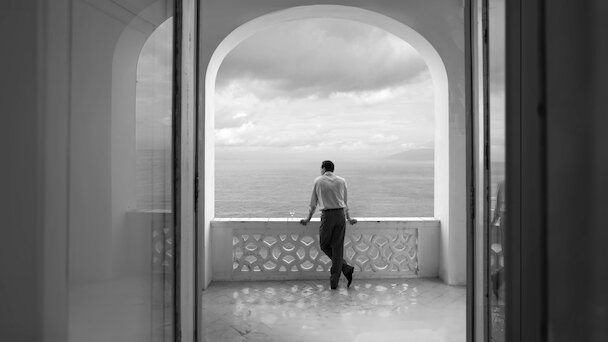by Christopher James
 Andrew Scott takes on the titular role of Tom Ripley in Steve Zaillian's latest rendition, "Ripley," on Netflix.
Andrew Scott takes on the titular role of Tom Ripley in Steve Zaillian's latest rendition, "Ripley," on Netflix.
There’s something sacred about a favorite movie. Anthony Minghella’s 1999 masterpiece The Talented Mr. Ripley is a seminal film, burned into my brain as canon. Thus, there’s a certain amount of bias that is hard to overcome when judging a remake. It runs the risk of being so close to the original that it is redundant, or swings far enough away that it pales from the original.
The new Netflix limited series Ripley wisely distances itself from other renditions of the Patricia Highsmith novel, primarily through its gorgeous black-and-white cinematography and new approaches to casting. Writer-director Steve Zaillian has a clear, distinct vision of the tale that feels distinct. However, it prioritizes style over substance. Though filled with haunting beauty, this Ripley lacks personality and tension - sexual or otherwise...
 Tom Ripley (Scott) heads to Italy to bring rich boy Dickie Greenleaf (Johnny Flynn) home.Our first episode of this eight episode series introduces us to con artist Tom Ripley (Andrew Scott) in New York, running small tricks to get by. After a chance encounter with a private eye (Bokeem Woodbine), Tom tells some strategic lies that puts him face to face with shipping magnet, Herbert Greenleaf (Kennenth Lonergan). He dispatches Tom to go to Italy on the Greenleaf dime to convince his son Dickie (Johnny Flynn) to come home from gallivanting around. Upon his arrival, Tom ingratiates himself in Dickie’s life while he bleeds the Greenleaf family of their money. Dickie’s writer girlfriend, Marge (Dakota Fanning), is suspicious of Tom as he metaphorically and literally moves into their lover's paradise.
Tom Ripley (Scott) heads to Italy to bring rich boy Dickie Greenleaf (Johnny Flynn) home.Our first episode of this eight episode series introduces us to con artist Tom Ripley (Andrew Scott) in New York, running small tricks to get by. After a chance encounter with a private eye (Bokeem Woodbine), Tom tells some strategic lies that puts him face to face with shipping magnet, Herbert Greenleaf (Kennenth Lonergan). He dispatches Tom to go to Italy on the Greenleaf dime to convince his son Dickie (Johnny Flynn) to come home from gallivanting around. Upon his arrival, Tom ingratiates himself in Dickie’s life while he bleeds the Greenleaf family of their money. Dickie’s writer girlfriend, Marge (Dakota Fanning), is suspicious of Tom as he metaphorically and literally moves into their lover's paradise.
The cinematography by Robert Elswit recalls the Cinecitta Italian films of the 60s era where the story is set. This look informs every part of the DNA of this piece. Every character is framed almost like a portrait, foregrounded to show their true selves, whether that be beautiful or betraying some ugliness beneath them. There’s a sparseness to the visuals that is haunting. Tom Ripley is oftentimes shot from far away in very empty streets or squares - no matter where he goes, loneliness follows. This coolness and remove often keeps the audience at arm's length. Unfortunately, Zaillian underestimates our willingness to lean in for eight consecutive episodes.
 Dakota Johnson, Johnny Flynn and Andrew Scott all create specific renditions of their characters that differ greatly from the 1999 version.The actors also have fresh takes on their characters, providing some unique, new windows into familiar roles. Andrew Scott is a more subdued Ripley, approaching him as a cold-hearted and jaded man. Right when we meet him, there seems to be this contempt for the world that informs his capacity for violence we see unfold. Scott’s Tom isn’t necessarily slick, but he knows how to disappear. As the series moves forward, we don’t necessarily get further humanization of Tom. Instead, he becomes a more confident and detached psychopath.
Dakota Johnson, Johnny Flynn and Andrew Scott all create specific renditions of their characters that differ greatly from the 1999 version.The actors also have fresh takes on their characters, providing some unique, new windows into familiar roles. Andrew Scott is a more subdued Ripley, approaching him as a cold-hearted and jaded man. Right when we meet him, there seems to be this contempt for the world that informs his capacity for violence we see unfold. Scott’s Tom isn’t necessarily slick, but he knows how to disappear. As the series moves forward, we don’t necessarily get further humanization of Tom. Instead, he becomes a more confident and detached psychopath.
Since the show focuses less on understanding and empathizing with Tom, it directs that energy towards mocking the entitled couple of Dickie and Marge that are doomed as they are caught in Tom’s web of lies. Dakota Fanning takes an interesting take on Marge. Rather than embrace Gwyneth Paltrow’s warmth that turns cold and questioning, Fanning is always on guard. She sees Tom as a curious outsider trying to muscle in on “her Atrani.” This essential change is felt all the way down to Marge’s wardrobe. She’s a cold, mod, fashion girl who carries around a certain amount of apathy to the world around her, preferring to spend her time naval gazing by writing a book that the series mocks. Fanning sells us on this change well, but not all character revisions are as novel or interesting.
Though Ripley is the titular character, what becomes clear is that the heart of the story is Dickie Greenleaf. In the original film, Paltrow’s Marge says that when Dickie looks at you, “it's like the sun shines on you, and it's glorious. And then he forgets you and it's very, very cold.” Johnny Flynn is a talented actor, but his aloof portrayal of Dickie Greenleaf presents the most massive plot hole in the series. This is not a character that inspires obsession, longing or anger. There’s a very modern apathy to his Dickie, always in sunglasses half-trying a new hobby, like painting. With Jude Law in the film, we understand the fundamental truth about how he can attract the attention of everyone around him, keeping them close by snapping back and withholding his energy. By not getting Dickie right, it invalidates Ripley’s murderous actions. His violence should be a recoil from Dickie playing games with his heart, seducing him and pulling away. We see longing in the eyes of Andrew Scott’s Ripley, but never does it seem like Flynn’s Dickie is feeding or reciprocating any sort of feelings.
In addition to not quite nailing the character dynamic, there’s other more ungenerous critiques of our leading men. Watching these 40 year old men play a dexterous con man and feckless trust fund kid is a bit like watching Stockard Channing play a teenager in Grease. Sure, they have the skill to play the notes, but it’s hard to suspend disbelief that people at this age would find themselves in this situation, seemingly having just arrived to the adult world moments before the series starts.
 The Italian landscape looks glorious, yet haunting, in this new adaptation of Patricia Highsmith's novel.Fans of Highsmith’s novel may have a good time basking in the monochromatic beauty of Zaillian’s rendition. It certainly does provide something additive and additional to the 1999 film, a new way into a familiar tale. Yet, the additional time spent in the world of Ripley doesn’t necessarily lead us deeper into the plot. Daffy heiress Meredith Logue (iconically brought to life by Cate Blanchett), who always walks in at the exact right (or wrong) time to stir up drama, is deeply missed, as is sweet composer Peter Smith Kingsley (played by Jack Davenport in the film).
The Italian landscape looks glorious, yet haunting, in this new adaptation of Patricia Highsmith's novel.Fans of Highsmith’s novel may have a good time basking in the monochromatic beauty of Zaillian’s rendition. It certainly does provide something additive and additional to the 1999 film, a new way into a familiar tale. Yet, the additional time spent in the world of Ripley doesn’t necessarily lead us deeper into the plot. Daffy heiress Meredith Logue (iconically brought to life by Cate Blanchett), who always walks in at the exact right (or wrong) time to stir up drama, is deeply missed, as is sweet composer Peter Smith Kingsley (played by Jack Davenport in the film).
Also disappointing is the revisioning of suspicious lush Freddie Miles, who was a threatening but exciting lightning rod with the great Phillip Seymore Hoffman. In this retelling, Freddie is a Gen-Z walkabout, played by singer Eliot Sumner, who barely registers as a character that is supposed to be integral in pushing Tom further down his path of darkness. This underlines the central problem with the new Ripley. While Scott and Fanning provide interesting new calibrations to their characters, Flynn and Sumner drolly showcase the emptiness of the upper class. Yes, that’s a new take and very different from the sun-drenched aspirational view of the 1999 film. Unfortunately, it’s not dramatically compelling, especially over the course of a series.
One of the better additions is the focus on art, specifically the work of Caravaggio. It provides a beautiful anchoring point to our story, tying the themes of beauty and destruction together in an engaging way. There is a lot of beauty in this new haunting Ripley, if only it had nailed some of the other elements that made this story such a timeless epic that bears revisiting. C

All eight episodes of Ripley are currently streaming on Netflix.